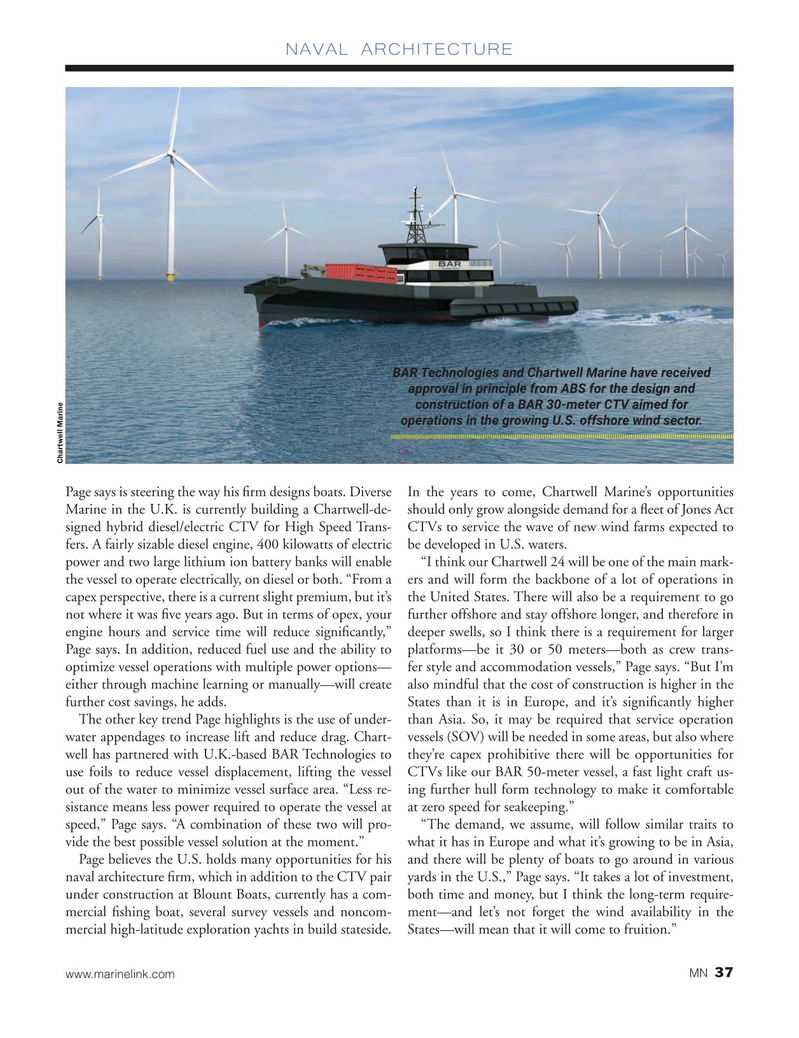
Page 37: of Marine News Magazine (September 2020)
Offshore Annual
Read this page in Pdf, Flash or Html5 edition of September 2020 Marine News Magazine
NAVAL ARCHITECTURE
BAR Technologies and Chartwell Marine have received approval in principle from ABS for the design and construction of a BAR 30-meter CTV aimed for operations in the growing U.S. offshore wind sector.
Chartwell Marine
Page says is steering the way his ? rm designs boats. Diverse In the years to come, Chartwell Marine’s opportunities
Marine in the U.K. is currently building a Chartwell-de- should only grow alongside demand for a ? eet of Jones Act signed hybrid diesel/electric CTV for High Speed Trans- CTVs to service the wave of new wind farms expected to fers. A fairly sizable diesel engine, 400 kilowatts of electric be developed in U.S. waters.
power and two large lithium ion battery banks will enable “I think our Chartwell 24 will be one of the main mark- the vessel to operate electrically, on diesel or both. “From a ers and will form the backbone of a lot of operations in capex perspective, there is a current slight premium, but it’s the United States. There will also be a requirement to go not where it was ? ve years ago. But in terms of opex, your further offshore and stay offshore longer, and therefore in engine hours and service time will reduce signi? cantly,” deeper swells, so I think there is a requirement for larger
Page says. In addition, reduced fuel use and the ability to platforms—be it 30 or 50 meters—both as crew trans- optimize vessel operations with multiple power options— fer style and accommodation vessels,” Page says. “But I’m either through machine learning or manually—will create also mindful that the cost of construction is higher in the further cost savings, he adds. States than it is in Europe, and it’s signi? cantly higher
The other key trend Page highlights is the use of under- than Asia. So, it may be required that service operation water appendages to increase lift and reduce drag. Chart- vessels (SOV) will be needed in some areas, but also where well has partnered with U.K.-based BAR Technologies to they’re capex prohibitive there will be opportunities for use foils to reduce vessel displacement, lifting the vessel CTVs like our BAR 50-meter vessel, a fast light craft us- out of the water to minimize vessel surface area. “Less re- ing further hull form technology to make it comfortable sistance means less power required to operate the vessel at at zero speed for seakeeping.” speed,” Page says. “A combination of these two will pro- “The demand, we assume, will follow similar traits to vide the best possible vessel solution at the moment.” what it has in Europe and what it’s growing to be in Asia,
Page believes the U.S. holds many opportunities for his and there will be plenty of boats to go around in various naval architecture ? rm, which in addition to the CTV pair yards in the U.S.,” Page says. “It takes a lot of investment, under construction at Blount Boats, currently has a com- both time and money, but I think the long-term require- mercial ? shing boat, several survey vessels and noncom- ment—and let’s not forget the wind availability in the mercial high-latitude exploration yachts in build stateside. States—will mean that it will come to fruition.” 37 www.marinelink.com MN

 36
36

 38
38
